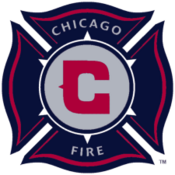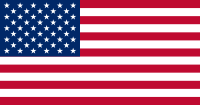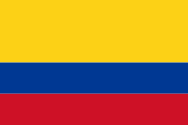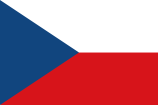Chicago Fire (soccer)
 |
|||||||||||||||||||||||||||
| Full name | Chicago Fire | ||||||||||||||||||||||||||
|---|---|---|---|---|---|---|---|---|---|---|---|---|---|---|---|---|---|---|---|---|---|---|---|---|---|---|---|
| Nickname(s) | The Fire La Maquina Roja, Men in Red, CF97, Strażacy (Firemen), Die Roten (The Reds) |
||||||||||||||||||||||||||
| Founded | 1997 | ||||||||||||||||||||||||||
| Stadium | Toyota Park Bridgeview, IL (Capacity: 20,000) |
||||||||||||||||||||||||||
| Chairman | |||||||||||||||||||||||||||
| Coach | |||||||||||||||||||||||||||
| League | Major League Soccer | ||||||||||||||||||||||||||
| 2008 | Eastern Conference: 2nd Overall: 3rd Playoffs: Conference Finals |
||||||||||||||||||||||||||
| First game | Chicago Fire 2–0 Miami Fusion (Lockhart Stadium; March 21, 1998) |
||||||||||||||||||||||||||
| Largest win | 7–0 vs Kansas City (Arrowhead Stadium; July 4, 2001) |
||||||||||||||||||||||||||
| Largest defeat | 1–5 vs NE Revs (Gillette Stadium; August 30, 2003) 2–6 vs Columbus Crew (Crew Stadium; October 26, 2003) |
||||||||||||||||||||||||||
| All-time top scorer | |||||||||||||||||||||||||||
| Supporters groups | Section 8 Chicago Barn Burners 1871, Fire Ultras '98, Ultras Red-Side, Sector Latino, Mike Ditka Street Crew, Arsonists, L97 |
||||||||||||||||||||||||||
| Honors | MLS Cup (1) Supporters' Shield (1) U.S. Open Cup (4) |
||||||||||||||||||||||||||
|
|||||||||||||||||||||||||||
The Chicago Fire are a professional soccer club based in the Chicago suburb of Bridgeview, Illinois, USA. It participates in Major League Soccer. The team was founded October 8, 1997 on the 126th anniversary of the Great Chicago Fire of 1871. In 1998, their first season in the league, the Fire won the MLS Cup as well as the U.S. Open Cup (the "double"). They have also won the 2000, 2003, and 2006 U.S. Open Cup.
The Chicago Fire has had a cooperative agreement with Monarcas Morelia, a Mexican First Division football club, since 2001. The partnership incorporates playing, coaching, and executive personnel, as well as sharing of business and development practices.
The club also has - through its reserves program, the Chicago Fire Premier amateur team playing in the Premier Development League, and the Chicago Fire Juniors youth teams - a substantial youth development system by American standards. It also has a charitable community entity, the FireWorks for Kids Foundation.
The official team colors are red and white; black, navy blue and sky blue have also been used by the Fire as accent/alternate colors over its history.
Contents |
History
Overview
The club was founded on October 8, 1997. They are the most successful club in the U.S. Open Cup since the foundation of Major League Soccer, winning championships in 1998, 2000, 2003, and 2006. Chicago's chief rival is FC Dallas. Since 2001, the two teams compete annually for the Brimstone Cup (established by the fans of both teams), which goes to the victor in the season series between them. While FC Dallas remains the most historically heated rival, recent years have fostered venom between the Fire and the New England Revolution with the clubs ending each other's season every year since 2001. The Fire originally played at Soldier Field, but now have their own stadium, Toyota Park at 71st and Harlem Avenue. Toyota Park is owned by the Village of Bridgeview and operated by the owners of the Fire, Andell Holdings -- who purchased the club in 2007. The Fire also keeps a close connection with its predecessor team the Chicago Sting by holding frequent commemmorative events, reunions, and wearing Sting-inspired shirts.
A number of famous players have worn the Fire shirt, including the US internationals Chris Armas, Frank Klopas, Eric Wynalda, DaMarcus Beasley, Josh Wolff, Tony Sanneh, Carlos Bocanegra, and Justin Mapp; and other Americans like Jesse Marsch, C.J. Brown, Ante Razov, Zach Thornton, and Chris Rolfe. Chicago has also imported both established international talent such as Peter Nowak, Lubos Kubik, Hristo Stoichkov, Tomasz Frankowski, and Cuauhtémoc Blanco; and younger developmental players like Damani Ralph, Ivan Guerrero, Bakary Soumare, and Patrick Nyarko.
Foundation and Success (97-02)
Founded on the anniversary of the Great Fire in a 1997 ceremony at Navy Pier, the Chicago Fire Soccer Club immediately tapped into the ethnic makeup of its city, bringing in Polish players like Peter Nowak, Jerzy Podbrozny, and Roman Kosecki, Mexican Jorge Campos, and Czech Lubos Kubik. While all showed their talent while playing for Chicago (especially Nowak, the captain for 5 years) it was the young American players that overall proved most successful and integral to success continuing to this day. The club, against all expectation, completed the "double" in 1998: beating DC United in the league final at the Rose Bowl to take the MLS Cup, and a week later defeating the Columbus Crew in Chicago to win the U.S. Open Cup.
Success continued for several seasons to come, reaching the 2000 MLS Cup Final (only to lose to Kansas City) and winning the 2000 U.S. Open Cup. Notable internationally seasoned players like Hristo Stoitchkov, and young American talents such as DaMarcus Beasley competed for the club's first head coach, Bob Bradley.
Nomadic Existence (02-05)
After spending the season exiled to play in west suburban Naperville, Illinois while Soldier Field underwent massive renovations, Coach Bradley left unexpectedly after the 2002 season to lead the MetroStars, the club from his home state of New Jersey. After an extensive search the team selected Dave Sarachan, the top assistant on the US national team, to lead the Fire. Chicago, returning to play again at Soldier Field, qualified for the 2003 league final, capturing the 2003 MLS Supporters' Shield (awarded for the league's best regular season record) and winning the 2003 U.S. Open Cup. 2003 also saw team captain Peter Nowak retire and take a position in the front office, only to depart a year later to become coach at DC United. New talents emerged for the team, including Jamaican striker Damani Ralph and Justin Mapp. The growing strength of the Eastern Conference made Chicago's league life more difficult in ensuing seasons, and they missed the playoffs in 2004 for the first time in their history.
Upheaval and New Home (05-07)
The 2005 season began abruptly with the unexpected dismissal of popular club president Peter Wilt by owners AEG despite the brokering of a $100m stadium deal in Bridgeview, and replaced him immediately with Metrostars executive John Guppy; a move decried by most fans, many players, and club staff. [1] The year was also notable for the blockbuster exhibition match against A.C. Milan and the shocking 4-0 away defeat of DC United in the first round of the league playoffs.
In 2006, the club moved from Soldier Field into a $100m purpose-built 20,000 capacity stadium at the corner of 71st Street and Harlem Avenue in Bridgeview, on the southwest side of Chicago. A unspectacular league campaign followed, but an impressive cup run led to the 2006 U.S. Open Cup title.
Despite a record of consistent success throughout its history, especially in the U.S. Open Cup, the anxiety to win another league title continued to grow. Coach Sarachan entered 2007, his fifth season in charge, under intense pressure from fans and the club to produce a league championship sooner rather than later. On April 3, 2007, the Fire signed Mexican international and América star Cuauhtémoc Blanco to a Designated Player contract. Blanco would join the team at the conclusion of his contract with Club America that June. Although the exact salary details were not disclosed per policy, Blanco would be under contract with the Fire until 2009. After a 3-0-1 start, the Fire won only one game of their next eight, leading to Sarachan's dismissal. John Guppy, after a brief search, named Millionarios manager Juan Carlos Osorio as head coach.
The Hauptman Era (07-)
On September 6, 2007, Andell Holdings, a Los Angeles-based private investment firm with global business and investment interests controlled by Chairman and Chief Executive Officer Andrew Hauptman, announced their acquisition of AEG's interests in the Chicago Fire Soccer Club and Toyota Park. While not officially disclosed, reports estimated the purchase price to be upwards of $35 million. [2] Behind Blanco and the acquisition of Osorio's central defender at Millionarios, Wilman Conde, the Fire went on an extended unbeaten run to close the season and qualify for the playoffs; only to fall to New England again in the Eastern Final at Gillette Stadium.
On December 10, 2007, the club announced the resignation of Juan Carlos Osorio. Osorio was named head coach of Red Bull New York on December 18, 2007. Chicago were compensated by New York for Osorio's hiring with draft picks and cash. Owner Andrew Hauptman filed tampering charges with the league in protest of RBNY's handling of the matter. [3]
On January 17, 2008, former Fire star Frank Klopas was named Technical Director in charge of player personnel, and longtime assistant Denis Hamlett was appointed head coach. Former Fire assistant and Dallas manager Mike Jeffries and retired Fire legend Chris Armas were hired as assistants.
In preparation for the 2008 season, Chicago signed Polish international forward Tomasz Frankowski, recently of Wolverhampton Wanderers and Lider Marmol. However, the club failed to reach an agreement on a contract for both starting goalkeeper Matt Pickens who departed for Queens Park Rangers F.C. and their drafted US U23 international Dominic Cervi.
On April 11th 2008, club owner and Chairman Andrew Hauptman relieved president John Guppy of his duties effective immediately. It is believed the removal of Guppy was due directly to the mishandling of the Juan Carlos Osorio departure over the past offseason[4]. Javier León, head of Andell Sports (the club's holding company) acted as interim president while a search was conducted, while many fans called for the reinstatement of former club president Peter Wilt[5].
Chairman Andrew Hauptmann named former Chicago Bears executive Dave Greeley club president on August 26th 2008[6]. Greeley has been cited as dismissive and insulting to the Fire and the sport of soccer in his previous role with the Chicago Bears by former Fire executives [7].
Club logo and colors
The Chicago Fire logo is derived from the standard style of a Fire Department's crest (also shown by the Chicago Fire Department). The shape is also known as a Florian's cross, often confused with the Maltese cross, and was picked in part due to the wishes of original GM Peter Wilt to create an image that was both as timeless as those of the NHL Original Six and evocative of European soccer. There is a stylized 'C' in the center representing Chicago, similar to the logos of the Bears and Cubs. The six star points around the center reference the four six-pointed stars in the municipal flag of the City of Chicago. The four stars in the city's flag represent the four monumental events in the history of the city, the Great Chicago Fire of 1871, the 1893 World's Fair, the 1933 World's Fair, and the Fort Dearborn Massacre.
Nike, the original club outfitters, wanted the team to be named Chicago Rhythm featuring a turqouise, black and green color scheme and a cobra adorned logo -- but team officials declined and developed the Fire identity.[8]
The original Fire shirts in 1998 were chosen because of their resemblance to a Chicago fireman's coat, featuring broad horizontal stripes across the torso and sleeves. The home jerseys were rendered in red and white with "FIRE" in silver on the front; the away shirts were white and black in this same style. Over the years the look has become more stylized but the core idea of the home shirts being all-red with a white horizontal chest stripe has remained constant, even though the uniform manufacturer has changed from Nike in 1998, to Puma in 2003, and then adidas in 2006. Away/secondary shirts have changed over the years from the aforementioned white/black in 1998, to white/navy, and the white/red style currently used. In 2005 a popular light blue-colored third shirt based on the Municipal Flag of Chicago was worn but discontinued during the change in manufacturer to adidas.
Aside from the badge, jersey style, and colors, the club and their fans frequently use the rich civic symbolism of Chicago in materials they produce. The six-pointed Chicago stars are prominent but the light blue color, municipal device (Y-circle), and skyline appear on the team website, scarves, and banners in the stadium. The Municipal Flag is also favored for display by fans of the club; somewhat akin to the use of the flag of Catalonia for FC Barcelona fans - but without the associated nationalism.
On January 11th, 2008, the team reached a deal with Best Buy to become the jersey sponsor.[9]
Fans
There is a considerable ultras culture for the club, a phenomenon fairly uncommon and new in the United States. Ultras groups and fan clubs occupy a standing room only general admission area directly behind the north goal in the Harlem End of Toyota Park (Sections 117 and 118) that is referred to as Section 8. This term stems from both the numbering of the original sector of Soldier Field they occupied, as well as the American military designation of discharged soldiers declared mentally unfit for service. Section 8 Chicago, the Independent Supporters' Association for the Chicago Fire, oversees the activities of the various groups; they include Barn Burners 1871 (the oldest group, established before the club was founded), Fire Ultras '98 (a Polish ultras group), and Ultras Red-Side (a multi ethnic ultras group). Other smaller groups are Sector Latino (a Latin "barra"-style group), Mike Ditka Street Crew, Whiskey Brothers Aught Five, "The Last Ward", "Red Scare", Blitzer Mob and Arsonists. Though emulating varied support styles from Chicago and throughout the world, groups as part of Section 8 are allied and generally fall under the ultras designation. Section 8 Chicago ISA is a non-profit organization recognized by the state of Illinois.
Other than the supporters' groups, the club is known for its stadium wide vocal and visual support, particularly for matches of great competitive importance. Call-and-response cheering amongst the crowd is commonplace. Toyota Park, during Fire matches, are one of the few American sports environments to periodically engage in acts of tifo, or visual displays put on by fans before the match to show their pride and inspire the players on the field.
Players and coaches
Current Roster
As of August 8, 2008. [10]
|
|
Notable former players
This list of former players includes those who received international caps while playing for the team, made significant contributions to the team in terms of appearances or goals while playing for the team, or who made significant contributions to the sport either before they played for the team, or after they left. It is clearly not yet complete and all inclusive, and additions and refinements will continue to be made over time.
|
|
Head coaches
 Bob Bradley (1998–2002)
Bob Bradley (1998–2002) Dave Sarachan (2003—2007)
Dave Sarachan (2003—2007) Juan Carlos Osorio (2007)
Juan Carlos Osorio (2007) Denis Hamlett (2008–)
Denis Hamlett (2008–)
Front office
Club presidents
- Robert Sanderman (1997–2000)
- Peter Wilt (2001–2005)
- John Guppy (2005–2008)
- Javier León (2008, interim)
- Dave Greeley (2008—)
General Managers
- Peter Wilt (1997–2005)
- John Guppy (2005–2008)
Assistant Coaches
- Mike Jeffries (1998–2000; 2008–)
- Chris Armas (2008—)
- Daryl Shore (2000—
Team Physicians
- Preston Wolin (1998—)
- Gilberto Muñoz (1999—)
Ring of Fire
The "Ring of Fire" was established in 2003 by the Chicago Fire and the Chicago Fire Alumni Association as permanent tribute to honor those who have made the Chicago Fire a proud and successful club over the course of its history. Aside from the initial member, only "Ring of Fire" members can select new inductees, and no more than one can be selected any year. The names of the "Ring of Fire" are prominently displayed in Chicago's home stadium. On July 22, 2006, the first former front office member, ex-President and General Manager Peter Wilt, was selected for induction into the "Ring of Fire."
 10 Peter Nowak (inducted 2003)
10 Peter Nowak (inducted 2003) 41 Frank Klopas (inducted 2004)
41 Frank Klopas (inducted 2004) 3 Luboš Kubík (inducted 2005)
3 Luboš Kubík (inducted 2005) Former General Manager & Club President Peter Wilt (inducted 2006)
Former General Manager & Club President Peter Wilt (inducted 2006) Former Head Coach Bob Bradley (inducted 2007)
Former Head Coach Bob Bradley (inducted 2007)
Honors
Domestic
- MLS Cup:
- Winner (1): 1998
- Runner-up (2): 2000, 2003
- MLS Supporters' Shield:
- Winner (1): 2003
- Runner-up (2): 2000, 2001
- US Open Cup:
- Winner (4): 1998, 2000, 2003, 2006
- Runner-up (1): 2004
International
- CONCACAF Champions Cup:
- Third-place (2): 1999, 2004
International competition
- 1999 CONCACAF Champions' Cup
- Quarterfinals v.
 Joe Public F.C. -- 2:0
Joe Public F.C. -- 2:0 - Semifinals v.
 LD Alajuelense -- 1:1 (Alajuela advance 5:4 on penalties)
LD Alajuelense -- 1:1 (Alajuela advance 5:4 on penalties) - Third place game v.
 D.C. United -- 2:2
D.C. United -- 2:2
- Quarterfinals v.
- 2002 CONCACAF Champions' Cup
- 1st round v.
 CSD Municipal -- 2:0, 1:0 (Fire advance 3:0 on aggregate)
CSD Municipal -- 2:0, 1:0 (Fire advance 3:0 on aggregate) - Quarterfinals v.
 Monarcas Morelia -- 0:2, 2:1 (Monarcas advance 3:2 on aggregate)
Monarcas Morelia -- 0:2, 2:1 (Monarcas advance 3:2 on aggregate)
- 1st round v.
- 2004 CONCACAF Champions' Cup
- Quarterfinals v.
 CL Financial San Juan Jabloteh -- 2:5, 4:0 (Fire advance 6:5 on aggregate)
CL Financial San Juan Jabloteh -- 2:5, 4:0 (Fire advance 6:5 on aggregate) - Semifinals v.
 Deportivo Saprissa -- 0:2, 2:1 (Saprissa advance 3:2 on aggregate)
Deportivo Saprissa -- 0:2, 2:1 (Saprissa advance 3:2 on aggregate)
- Quarterfinals v.
Year-by-year
| Year | Reg. Season | Playoffs | Open Cup | CONCACAF Champions' Cup |
SuperLiga |
|---|---|---|---|---|---|
| 1998 | 2nd, West | Champions | Champions | Did not qualify | Started in 2007 |
| 1999 | 3rd, West | Quarterfinals | Round of 16 | 3rd place | |
| 2000 | 1st, Central | Final | Champions | Did not qualify | |
| 2001 | 1st, Central | Semifinals | Quarterfinals | Not held | |
| 2002 | 3rd, East | Quarterfinals | Round of 16 | Quarterfinals | |
| 2003 | 1st, East* | Final | Champions | Did not qualify | |
| 2004 | 5th, East | Did not qualify | Final | Semifinals | |
| 2005 | 3rd, East | Semifinals | Semifinals | Did not qualify | |
| 2006 | 3rd, East | Quarterfinals | Champions | Did not qualify | |
| 2007 | 4th, East | Semifinals | Round of 16 | Did not qualify | Did not participate |
| 2008 | 2nd, East | Semifinals | Quarterfinals | Did not qualify | Did not qualify |
* Won MLS Supporters' Shield
Club records
- Games:
 C.J. Brown, 249
C.J. Brown, 249 - Goals:
 Ante Razov, 76
Ante Razov, 76 - Assists:
 Peter Nowak, 48
Peter Nowak, 48 - Shutouts:
 Zach Thornton, 57
Zach Thornton, 57
MLS regular season only, through 2007
- All-Time regular season record: 143-108-54 (Through 2007 regular season)
Golden Boot Winner
The Golden Boot Winner is the leading goal scorer at the end of the season (only goals in MLS count). List of winners begin from 2005 to present season.
| Year | Name | Country | Goals |
|---|---|---|---|
| 2008 | Chris Rolfe | 9 | |
| 2007 | Chad Barrett | 7 | |
| 2006 | Andy Herron | 8 | |
| 2005 | Chris Rolfe | 8 |
Home stadiums
- Soldier Field (1998–2001, 2004–2005)
- Cardinal Stadium (2002–2003)
- Toyota Park (2006—)
Average attendance
regular season/playoffs
- 1998: 17,887/22,677
- 1999: 16,016/8,197
- 2000: 13,387/8,431
- 2001: 16,388/11,239
- 2002: 12,922/9,434
- 2003: 14,005/14,961
- 2004: 17,153/missed playoffs
- 2005: 17,238/11,493
- 2006: 14,088/10,217
- 2007: 16,490/17,834
- 2008: 17,034/17,312
- All-Time: 15,717
Club system
- Chicago Fire — MLS (First Team)
- Chicago Fire Reserves — MLS Reserves Division (Professional Reserve Team)
- Chicago Fire Premier — USL Premier Development League (4th division) (U20 and U23 Collegiate Amateur Select Teams)
- Chicago Fire Academy — Statewide (U14 to U18 Youth Select Teams); run in conjunction with Illinois ODP
- Chicago Fire Juniors — Local (U8 to U23 Youth Club); satellite clubs in Milwaukee, Western Michigan and Mississippi.
Television and radio
Matches are televised locally by WPWR Channel 50. Fred Huebner and Chris Doran comprise the announcing team, with Sarah Kustok and Amy Freeze alternating sideline reporting duties. Select matches are also nationally broadcast on either TeleFutura (TeleFuture), ESPN, HDNET, or Fox Soccer Channel.
On radio, the Fire have all matches broadcast in Spanish by "La Tremenda" WRTO-AM; Oscar Guzman, Adrian Camacho and Enrique Fernandez handle the announcers duties. All matches are also broadcast in Polish by WNVR with Jacek Zielinski doing the announcing and Leszek Dorosz on commentary.
Radio Show
A weekly radio show is produced during the season at 6:00 PM every Tuesday on WXAV 88.3 FM. The show, "Chicago Fire Soccer Weekly", is broadcast on the campus of Saint Xavier University in Chicago. Hosts include WXAV Program Director Angelo Bonadonna, Promotions Director Kevin Kellam, and Sports Director Terry Bonadonna.
References
- ↑ "Fire Fire Peter Wilt, Fans Protest". chicagoist.com. Retrieved on December 31, 2007.
- ↑ Hauptman to Purchase Chicago Fire
- ↑ "The owner that won't let go". soccerbyives.net.
- ↑ "Fire dismisses Guppy as president". chicagosports.com.
- ↑ "Guppy dismissed". section8chicago.com.
- ↑ "Fire name Greeley club president". chicago-fire.com.
- ↑ "We meet again...". chicagoredstars.com.
- ↑ USSP: "Sounders Already Scoring"
- ↑ Red Card | ChicagoSports | Blog
- ↑ http://web.mlsnet.com/players/roster.jsp?club=t100
External links
- Chicago Fire Official club website
- Chicago Fire - History Official club history (with photos and uniforms)
- Section 8 Chicago ISA Independent Supporters' Association website
- Official Fire Message Board, courtesy of BigSoccer
- Chicago Fire Premier, PDL (amateur) Affiliate Club
- Chicago Fire Juniors, Chicago-based Youth Affiliate Club
- West Michigan Fire Juniors, Michigan-based Youth Affiliate Club
- Elm Grove Soccer, Milwaukee-based Youth Affiliate Club
- Chicago Fire Juniors of Mississippi, Mississippi-based Youth Affiliate Club
- Chicago Fire Soccer
|
|||||||||||||||||||||||||||||||||||||||||||||||
|
|||||||||||||||||||||||||||
|
|||||||||||||||||||||||||||||||
